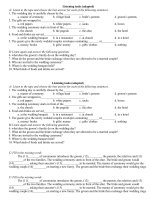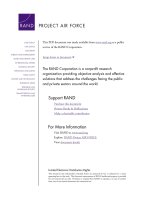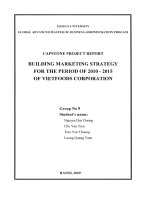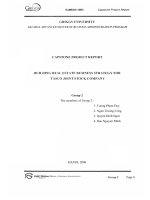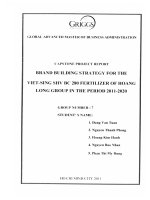Semi transparent building integrated photovoltiac (BIPV) windows for the tropics
Bạn đang xem bản rút gọn của tài liệu. Xem và tải ngay bản đầy đủ của tài liệu tại đây (5.4 MB, 280 trang )
SEMI-TRANSPARENT BUILDING-INTEGRATED
PHOTOVOLTAIC (BIPV) WINDOWS FOR THE
TROPICS
NG POH KHAI
(B.Sc. (Building) (Hons.), NUS)
A THESIS SUBMITTED
FOR THE DEGREE OF DOCTOR OF PHILISOPY
DEPARTMENT OF ARCHITECTURE
NATIONAL UNIVERSITY OF SINGAPORE
2014
i
DECLARATION
I hereby declare that the thesis is my original work and it has been written by me in its
entirety. I have duly acknowledged all the sources of information which have been
used in the thesis.
The thesis has also not been submitted for any degree in any university previously.
_____________
Ng Poh Khai
06 January 2014
ii
ACKNOWLEDGEMENTS
Many people have contributed directly or indirectly towards the successful
completion of this doctoral thesis and I would like to take this opportunity to thank
them.
First, I would like to thank Associate Professor Nalanie Mithraratne for her constant
guidance for my research and taking me under her expert supervision when I needed
to find a new main supervisor. I appreciate her efforts in reviewing my publications
and numerous versions of this thesis and also her time in checking my progress
despite her busy schedule with her teaching and other research commitments. Her
support was tremendous whenever I faced difficulties and she would always provide
me with the utmost backing to ensure that all goes to plan. She will constantly serve
as an inspirational figure to me, whenever I take on supervision or managerial roles in
my future work capacities. In addition, I am also thankful of my other thesis
committee members: Assistant Professor Kua Harn Wei, for being there whenever I
needed kind advice or assistance in both academic and non-academic areas, and
Professor Stephen Wittkopf, for his direction in my initial years of research and
providing me the opportunity to commence my PhD study.
Second, I would like to thank the staff from School of Design and Environment as
well as the Department of Architecture. Special thanks are due to Associate Professor
Wong Yunn Chii (Head of Department) and Associate Professor Bobby Wong Chong
Thai (Deputy Head for Research) for admitting me into the department and also
awarding me with a research scholarship to pursue a doctoral degree. Sincere
appreciation also goes out to Assistant Professor Abel Tablada for allowing me to
iii
assist him in teaching duties and sharing his experiences with me. Special mention
goes out to non-academic staffs such as Miss Goh Lay Fong and Miss Katherine
Chong who were always there for me whenever I needed help or assistance in
administrative paper work. Also, I would like to express my heartfelt thanks to my
friends and colleagues at the Solar Energy Research Institute of Singapore (SERIS)
where they were always there to support my research work and provide assistance.
These people include Dr. Thomas Reindl, Mr. Choo Thian Siong, Dr. Daniel Sun
Weimeng, Dr. Chen Fangzhi, Dr. Lipi Mohanty, Mr. Pang Chee Kok, Mr. Yang
Xiaoming, Mr. Ouyang Jieer, Mr. Du Hui, Mr. Selvam Valliappan, Mr. Zhang
Xiangjing, Miss Marinel Dungca, Miss Shimalee Fathima and Miss Religiana
Hendarti.
Third, I would like to thank my family for their constant care and concern which I am
deeply indebted towards. Their unconditional love has been a strong pillar of support
for me to sustain my momentum throughout my past eight years of studies.
Last but not least, I dedicate this thesis to my fiancée, Miss Alina Hah Min Ee, who
was always there for me for the past 12 years of my life. Her endless giving towards
me and our relationship despite our ups and downs is something I am sincerely
appreciative for and will always treasure.
iv
TABLE OF CONTENTS
DECLARATION i
ACKNOWLEDGEMENTS ii
TABLE OF CONTENTS iv
SUMMARY vii
LIST OF PUBLICATIONS xi
LIST OF FIGURES xiii
LIST OF TABLES xvi
ABBREVIATIONS xix
CHAPTER 1 INTRODUCTION 1
1.1 Global Energy Use 1
1.2 Energy Consumption in Singapore’s Building Sector 3
1.3 Solar Energy 4
1.4 Statement and Research Objectives 8
1.5 Organisation of Thesis 11
CHAPTER 2 LITERATURE REVIEW 15
2.1 Daylighting 15
2.2 Fenestration 19
2.3 Photovoltaic Technology 28
2.4 Building-Integrated Photovoltaic (BIPV) 32
2.5 Life Cycle Assessment 43
2.6 Life Cycle Cost Assessment 49
2.7 PV Integration during Building Design 52
2.8 Discussion and Identification of Knowledge Gap 54
2.9 Summary 56
CHAPTER 3 RESEARCH METHODOLOGY 58
3.1 Research Approach 58
3.2 Selection of BIPV Modules 62
3.3 Measurement Designs 64
3.4 Building Energy Simulations 71
3.5 Life Cycle Assessment 72
3.6 Semi-Transparent BIPV Decision Support Tool 74
3.7 Summary 75
v
CHAPTER 4 SEMI-TRANSPARENT BIPV MEASUREMENTS 77
4.1 Electrical Measurements 77
4.2 Thermal Measurements 85
4.3 Optical Measurements 101
4.4 LSG Ratio of Tested Semi-Transparent BIPV Modules 105
4.5 Comparison of Measurement Results 106
4.6 Summary 108
CHAPTER 5 IMPACTS OF SEMI-TRANSPARENT BIPV
WINDOWS ON BUILDING ENERGY 109
5.1 Profile of Singapore’s Hot and Humid Climate 109
5.2 Holistic Multi-Functional Index – Net Electrical Benefit 111
5.3 Semi-Transparent BIPV Windows in Singapore Buildings 112
5.4 Performance Simulation 116
5.5 Results and Discussion 122
5.6 Comparison of BIPV windows against conventional glazing 126
5.7 Redefining “Net Electricity Benefit” 129
5.8 Summary 131
CHAPTER 6 LIFE CYCLE ASSESSMENT 133
6.1 Introduction 133
6.2 Life Cycle Assessment of BIPV 133
6.3 Life Cycle Energy Performance 134
6.4 Life Cycle Resource Use 135
6.5 Life Cycle Environmental Performance 141
6.6 Life Cycle Economic Performance 146
6.7 Sensitivity of Results 149
6.8 Summary 160
CHAPTER 7 GRAPHICAL REPRESENTATION OF SEMI-
TRANSPARENT BIPV LONG TERM
PERFORMANCE FOR BUILDING USE 162
7.1 Categories and Criteria for Graphical Matrix 162
7.2 Development of Selection Matrix 164
7.3 Example of selection process 167
7.4 Summary 169
vi
CHAPTER 8 CONCLUSIONS 170
8.1 Summary of Key Findings 170
8.2 Limitations of Study 174
8.3 Significance and Major Contribution to Architecture 175
8.4 Recommendations for Future Research 176
BIBLIOGRAPHY 178
APPENDICES 191
APPENDIX A – BIPV Manufacturer’s Data Sheets 192
APPENDIX B – EnergyPlus Input File of Building Model 207
APPENDIX C – LCA Unit Process Raw Data 252
APPENDIX D – Contractors’ Quotation for Glazing 256
vii
SUMMARY
In recent years, climate change mitigation has been one of the global agendas.
Due to the significant contribution by the building energy use to this issue,
there has not only been an increasing awareness in not only improving
building energy efficiency but also promoting the use of clean or renewable
technologies. Designing for energy efficient buildings can reduce electricity
consumption and the adoption of renewable technologies in such buildings can
result in zero- (or even plus-) energy buildings, which consume zero energy
(or even generate more energy for other users) over a year. For tropical areas,
the abundance of sunlight makes it more appropriate for solar technologies to
be integrated in buildings. In many cities worldwide, such as Singapore, high-
rise buildings are dominant in the urban areas. With limited roof area, the next
possible area for photovoltaic integration is the vertical façade where semi-
transparent building-integrated photovoltaic (BIPV) windows can be installed.
Combining photovoltaic technology in building fabric can contribute to
overall energy efficiency through electricity generation, solar heat gain effects
and daylighting.
This study investigated the performance of semi-transparent BIPV windows in
Singapore’s tropical climate. First, commercially-available BIPV modules
were laboratory tested for their electrical, thermal and optical properties. The
electrical measurements analysed the effects on power generation of modules
consisting of different photovoltaic technologies when exposed to different
irradiance (direct/diffuse) and shading conditions. The thermal and optical
viii
measurements determined the U-value, solar heat gain coefficient and visible
light transmittance of both single and double-glazed modules.
The measured data were utilised in building energy simulations to determine
their impacts on building energy consumption in tropical conditions in
Singapore. By first examining Singapore’s weather data, it was realised that
all orientations received relatively high sunlight due to its highly diffused
nature. The six selected semi-transparent BIPV modules were then used to
perform a parametric study on different window-to-wall ratios and orientations
in Singapore. A new index was formulated to evaluate the overall annual
performance of semi-transparent BIPV modules in terms of multifunctional
effects on building energy, by comparing them to double-glazed windows.
The results indicated that the Net Energy Benefits of BIPV can be very
different and depend on the Window-to-Wall Ratio adopted, when compared
to an opaque wall. The double-glazed modules showed good performance due
to their better thermal performance, even though they have slightly lower
photovoltaic efficiencies. It is also possible to integrate semi-transparent BIPV
modules on facades that do not face the sun path in Singapore. An analysis to
compare performance of the six modules against conventional double-glazed
windows indicated that the semi-transparent BIPV modules are capable of
increasing a building’s energy efficiency and is a much better alternative for
double-glazed window when choosing window façade materials.
Subsequently, a life cycle assessment was conducted to determine their long
term environmental and economic performances. The life cycle resource uses
ix
(materials, energy, transport, etc.) were first investigated using up-to-date
databases before adopting the building energy simulation results to assess the
life time performance. The environmental performance indicators selected
include greenhouse gas emissions, energy intensities, energy payback time and
energy return on energy investment. Economic performance indicators used
are payback period and return on investment. Sensitivity analyses were also
included to consider alternative manufacturing locations, effects of façade
shading from nearby buildings and possible future increases in electricity
tariffs.
The life cycle environmental performance results indicated Energy Pay Back
Time of less than two years and Energy Return On Energy Investment of up to
35 times for different modules and orientations. As for their economic
performance, the modules achieved varying results. Some modules are already
cheaper than double-glazed facades, after considering 30% subsidy that is
handed out by the Singapore government. The sensitivity results suggested
that manufacturing the modules in a nearby country can greatly decrease its
life cycle energy use. In addition, the shadowing effects of surrounding
buildings can decrease the overall effectiveness of BIPV systems. Results
from the economic sensitivity analysis indicated that any increase in electricity
prices improves the economic viability of semi-transparent BIPV systems. It
can greatly reduce the payback periods and even some BIPV systems which
did not achieve payback previously were able to do so with increased
electricity prices.
x
Lastly, the results were used to derive a framework aimed at providing a
simplified approach to facilitate the implementation of solar building
applications. The selection matrix included performance indicators which
would allow building designers to make quick and informed decisions.
xi
LIST OF PUBLICATIONS
Throughout the course of this graduate study research, the following
publications were produced (listed in chronological order):
Journal Papers
CHEN, F., WITTKOPF, S. K., NG, P. K. & DU, H. 2012. Solar heat gain
coefficient measurement of semi-transparent photovoltaic modules
with indoor calorimetric hot box and solar simulator. Energy and
Buildings, 53, 74-84.
NG, P. K., MITHRARATNE, N. & KUA, H. W. 2013. Energy analysis of
semi-transparent BIPV in Singapore buildings. Energy and Buildings,
66, 274-81.
NG, P. K., & MITHRARATNE, N. Lifetime performance of semi-transparent
building-integrated photovoltaic (BIPV) glazing systems in the tropics.
Renewable and Sustainable Energy Reviews, doi:
10.1016/j.rser.2013.12.044.
Conference Papers
Oral Presentations
SUN, W., NG, P. K. & OUYANG, J. E. 2011. Study of the Partial Shading
Impact on the PV Roof in Zero-Energy Building in Singapore with
PVSYS Simulations. Building Simulation 2011, 14-16 November
2011, Sydney, Australia. International Building Performance
Simulation Association (IBPSA).
NG, P. K. & MITHRARATNE, N. 2012. A Selection Framework for the
Integration of Semi-Transparent BIPV Windows in Singapore. 4th
International Network for Tropical Architecture. Singapore.
NG, P. K., MITHRARATNE, N. & WITTKOPF, S. 2012. Semi-Transparent
Building-Integrated Photovoltaic Windows: Potential Energy Savings
of Office Buildings in Tropical Singapore. Passive and Low-Energy
Architecture. Lima, Peru: PLEA.
NG, P.K.& MITHRARATE, N. 2013. Life Cycle Energy Performance of
Semi-Transaparent Building-Integrated Photovoltaic (BIPV) Windows
in Tropical Singapore. Sustainable Building 2013, 25-28 September
2013 Graz, Austria.
xii
Poster Presentations
WITTKOPF, S., KAMBADKONE, A., HE, Q. & NG, P. K. Development of a
Solar Radiation and BIPV Design tool as EnergyPlus plugin for
Google SketchUp. Building Simulation 2009, 27-30 July 2009,
Glasgow, Scotland. International Building Performance Simulation
Association (IBPSA).
SUN, W., WITTKOPF, S. & NG, P. K. Performance evaluation of selected
photovoltaic arrays in an zero-energy building in Singapore.
Renewable Energy 2010, 27 June - 2 July 2010 Yokohama, Japan.
NG, P. K., WITTKOPF, S. K. & SUN, W. Modelling the Impact of Glazing
Selection on Daylighting Performance of an Office Building in
Singapore Using EnergyPlus. Building Simulation 2011, 14-16
November 2011, Sydney, Australia. International Building
Performance Simulation Association (IBPSA).
xiii
LIST OF FIGURES
Figure 1:1 – World Energy Consumption 1
Figure 1:2 – Global Energy Consumption in Buildings 2
Figure 2:1 – LSG plot of 37 glazing specimens 27
Figure 2:2 – Typical photovoltaic I – V Curve 30
Figure 2:3 – Example of rooftop application of opaque photovoltaic modules
33
Figure 2:4 – Example of skylight application of spaced-out opaque wafer
modules 34
Figure 2:5 – Indoor view of a semi-transparent BIPV window 35
Figure 2:6 – Life-cycle assessment framework 44
Figure 3:1 – Overview of research approach 59
Figure 3:2 – Schematic diagram of laboratory setup for electrical
measurements 66
Figure 3:3 – Layout of SERIS thermal laboratory 69
Figure 4:1 – Polar plot of translucent fabric’s optical scatter 80
Figure 4:2 – Close-up of the photovoltaic modules tested for electrical
measurements 82
Figure 4:3 – Percentage difference of direct and diffuse irradiance 84
Figure 4:4 – Schematic of the SERIS calorimetric hot box 86
Figure 4:5 – General view of SERIS calorimetric hot box system in U-value
measurement mode (closed). 86
Figure 4:6 – General view of SERIS calorimetric hot box system (opened) 87
Figure 4:7 – Schematic of heat balance in the metering box 92
xiv
Figure 4:8 – Schematic section of SERIS calorimetric hot box system in
SHGC measurement mode 96
Figure 4:9 – General view of SERIS calorimetric hot box in SHGC
measurement mode 97
Figure 4:10 – Front view of solar simulator used for SHGC measurements 97
Figure 4:11 – Picture of integrating sphere in transmittance mode 102
Figure 4:12 – View of semi-transparent BIPV module during VLT
measurement using a large integrating sphere 103
Figure 5:1 – Monthly solar radiation for Singapore (direct/diffuse/total) 110
Figure 5:2 – Annual solar radiation for various orientations 111
Figure 5:3 – Overview of simulation methodology 116
Figure 5:4 – Plan view of the simulated office building 117
Figure 5:5 – Positions of daylighting reference points in a typical zone 119
Figure 5:6 – Illustration of continuous dimming relationship for simulated
building 120
Figure 5:7 – Long term predicted total building cooling load (over a period of
3 consecutive years) 121
Figure 5:8 – Effects of WWR on NEB for various modules on east façade
orientation 123
Figure 5:9 – Effects of WWR on NEB for various modules on west façade
orientation 123
Figure 5:10 – Effects of WWR on NEB for various modules on north façade
orientation 124
Figure 5:11 – Effects of WWR on NEB for various modules on south façade
orientation 124
xv
Figure 5:12 – Annual electricity consumption with nine window types
(lighting, air-conditioning & PV electricity generation included) 128
Figure 5:13 – NEB of the six semi-transparent BIPV windows (relative to
double-glazing) 130
Figure 5:14 – Percentage of total NEB savings of alternative window types
relative to double glazing 131
Figure 6:1 – Life cycle energy use at different life stages 144
Figure 6:2 – Energy and emissions intensity of PV generated electricity 145
Figure 6:3 – Illustration of obstruction objects to achieve reduced SVF 152
Figure 6:4 – Singapore electricity tariffs (2005–2013) 158
Figure 7:1 – Selection matrix representing six semi-transparent BIPV modules
and double glazing 167
Figure 7:2 – Selection matrix representing two semi-transparent BIPV
modules and double glazing 168
xvi
LIST OF TABLES
Table 2:1 – Summary of benefits which can add value to BIPV systems 36
Table 3:1 – Module data and specifications of semi-transparent BIPV modules
under investigation 63
Table 3:2 – Equipment and instrumentation used at SERIS PVPA facility 65
Table 3:3 – Equipment and instrumentation for SERIS thermal laboratory 68
Table 3:4 – Equipment and instrumentation of SERIS integrating sphere 70
Table 4:1 – Description and illustration of electrical measurement conditions
79
Table 4:2 – Specifications of photovoltaic modules tested for electrical
measurements 81
Table 4:3 – Results of electrical measurements investigating effects of shading
orientation 83
Table 4:4 – Results of electrical measurements investigating effects of
irradiance 83
Table 4:5 – U-value measurement results of semi-transparent BIPV modules
95
Table 4:6 – Standard environmental conditions for SHGC measurements 99
Table 4:7 – SHGC measurement results of semi-transparent BIPV modules100
Table 4:8 – IFT template excel file for recording of VLT 104
Table 4:9 – VLT measurement results of semi-transparent BIPV modules 105
Table 4:10 – LSG ratio of semi-transparent BIPV modules 106
Table 4:11 – Thermal and Optical BIPV Modules Performance (Measured
against Provided) 107
xvii
Table 5:1 – List if chosen BIPV modules and their adjustments of efficiencies
for energy simulation 115
Table 5:2 – Description of office building used for simulation 118
Table 5:3 – Construction details of the office building used for simulation . 118
Table 5:4 – Hourly variations office building model’s internal heat gains 119
Table 5:5 – Breakdown of positive impacts of semi-transparent BIPV modules
125
Table 5:6 – Properties of traditional and current window glazing types 127
Table 6:1 – Annual and life cycle energy performance as compared to double-
glazed window 135
Table 6:2 – Additional information on BIPV modules for LCA 136
Table 6:3 – Summary of data sources for each life cycle stage 137
Table 6:4 – Electricity mixes of various countries adopted for study 138
Table 6:5 – Port to port distances adopted for study 139
Table 6:6 – Life cycle energy and GHG emissions from BIPV assembly over
25 years 143
Table 6:7 – EPBT and EROEI for the six BIPV systems 146
Table 6:8 – Costs of supply of glazing, aluminium framing and installation of
double-glazed windows 147
Table 6:9 – Total costs and breakdown of the six semi-transparent BIPV
window systems and double-glazed windows 147
Table 6:10 – Costs of semi-transparent BIPV window systems after
government subsidy 148
Table 6:11 – Economic payback periods of the semi-transparent BIPV window
systems 149
xviii
Table 6:12 – Comparison of the six semi-transparent BIPV modules’ life cycle
CED under different scenarios 153
Table 6:13 – Comparison of the six semi-transparent BIPV modules’ life cycle
GHG emissions under different scenarios 154
Table 6:14 – EPBT and EROEI of the six semi-transparent BIPV modules
under different scenarios 155
Table 6:15 – Payback periods of the semi-transparent BIPV systems’ life cycle
cost for different scenarios 159
Table 7:1 – Consolidated data on performance indicators selected for the
matrix (only E/W) 166
Table 7:2 – Modified data (only E/W) on relative performance 166
xix
ABBREVIATIONS
BIPV - Building-Integrated Photovoltaic
BOS - Balance of Systems
CdTe - Cadium Telluride
CED - Cumulative Energy Demand
CH - Switzerland
CIGS - Copper Indium Gallium Selenide
COP - Coefficient of Performance
EPBT - Energy Payback Time
EROEI - Energy Return on Energy Investment
GHG - Greenhouse Gas
GLO - Global
LCA - Life Cycle Assessment
LCCA - Life Cycle Cost Analysis
LSG - Light-to-Solar-Gain
OCE - Oceanic
NEB - Net Energy Benefit
RER - Europe
SERIS - Solar Energy Research Institute of Singapore
SHGC - Solar Heat Gain Coefficient
SVF - Sky View Factor
VLT - Visible Light Transmittance
WWR - Window-to-wall Ratio
1
CHAPTER 1 INTRODUCTION
1.1 Global Energy Use
As shown in Figure 1:1, the world energy consumption increased by nearly
40% between 1990 and 2007. With the population growth rate expected to
increase at a rate of 0.8–1% annually (UN, 2009), coupled with rapid
urbanisation and development in developing countries, it can be safely
assumed that the world energy consumption will continue to increase. It has
been predicted that the global energy consumption will increase by another 8–
10% every five years till 2035 (EIA, 2010).
Figure 1:1 – World Energy Consumption
(Source: EIA, International Energy Outlook 2010, July 2010, pp. 9)
544
590
639
687
739
2
Globally, buildings represent 40% of primary energy usage and if the energy
consumed in manufacturing steel, cement, aluminium and glass used in
building construction is included, this number grows to more than 50%
(WBCSD, 2005). Several factors contribute to produce two broad trends
resulting in the alarming increase in building energy consumption. Within the
developing countries, there is increasing population growth, prosperity and
urbanisation. Urban living, higher incomes and more access to technologies
are associated with higher building energy use, especially for space and water
heating, appliances and equipment (Figure 1:2). In developed countries, there
is an inefficient building stock and also an increase in usage of services and
appliances. Many such properties are old, built before energy efficiency
regulations were enacted and with average annual replacement rate of around
2% (Gordon, 2008), will still be in use in 2050 (WBCSD, 2005).
Figure 1:2 – Global Energy Consumption in Buildings
(Based on: International Energy Agency, 2008, Worldwide Trends in Energy Use and
Efficiency)
Space Heating
53%
Appliances
21%
Water Heating
16%
Lighting Equipment
5%
Cooking
5%
3
1.2 Energy Consumption in Singapore’s Building Sector
The building sector consumes about a third of Singapore’s total electricity
production (BCA, 2010). The total operating energy consumption of a
building is usually attributed to heating, ventilating and air-conditioning
(HVAC) equipment, electrical artificial lighting, lifts and escalators,
equipment and appliances. Based on an audit conducted on 104 office
buildings, Lee and Majid (2004) concluded that in Singapore, the average
annual electricity consumption in the commercial building sector is 180–260
kWh/m
2
/yr. Past studies have shown the electrical consumption of individual
commercial buildings’ end-uses. In general, the distribution of energy by end-
use for commercial buildings was: air-conditioning, 50–60%; lighting, 15–
20%; vertical transportation, 5% and equipment, 10–15% (Lee and Majid,
2004, Chou et al., 1994).
With a large amount of energy consumed by buildings being channelled for
air-conditioning, there is also literature on the distribution of thermal loads.
The base cooling load is attributable to various sources as follows:
1. Solar radiation (25%);
2. Lighting (23%);
3. Ventilation and infiltration (19%);
4. Occupants (16%);
5. Wall and glass conduction (13%); and,
6. Others (4%). (Chou and Chang, 1997).
4
With Singapore’s tropical climate, it is easy to understand that commercial
buildings require a large amount of cooling and the main heat contributors are
actually from the facade (solar radiation, wall and glass conduction) and
artificial lighting, which generates heat in the process of providing sufficient
illumination. The design of high performance building facades to combat heat
gains has been imperative as a preferred passive design strategy as opposed to
active measures. Besides affecting the performance of office buildings through
thermal heat gains and daylighting, facades also play an important role in their
visual appeal.
In city states such as Singapore, land is a limited and valuable resource. With
many different land uses such as transportation, residential, nature reserve and
commercial competing for land, developments have to ensure that land use is
carefully designed and its potential is maximized. With the current population
of 5.31 million projected to reach 6.5–6.9 million by 2030 (NPTD, 2013), the
demand for high-rise buildings is increasing as they can help to alleviate land
constraints by fully utilizing the plot ratio to achieve maximum gross floor
area.
1.3 Solar Energy
Solar energy is widely regarded as a potential application of renewable energy
in buildings due to good availability in many places, especially in the tropics
with high sunshine hours all year round. The different uses of solar energy for
buildings can be classified into passive and active strategies (Eicker, 2003).
For passive solar energy use, the most important component is the window
5
and contributes to space heating and daylighting. As for active use, it is
primarily used to meet electricity requirements by photovoltaics, and to warm
water heating by solar thermal collectors. In air-conditioned buildings, thermal
cooling sorption processes can be powered by active solar components.
Photovoltaic (PV) technology can harness and convert incident solar energy
into electricity and has been used in many applications. In modern urban areas
with numerous high-rise buildings, PV systems that integrate renewable
energy with buildings known as building-integrated photovoltaic (BIPV) can
be a suitable form. With BIPV, the architectural, structural and aesthetic
integration of photovoltaic into buildings can allow the incorporation of
energy generation into urban structures (Pagliaro et al., 2010). According to
this concept, the photovoltaic modules become true construction elements
structurally serving as building exteriors, such as roofs, façade or skylight.
Building integration of photovoltaic is usually restricted to rooftop
installations or as opaque solar façade claddings. The rooftop provides the best
view factor and likely to receive more solar gains than any other building
façade, and therefore, likely to generate more electricity. However, in high-
rise buildings, roof top spaces are very limited, in addition to being sought
after by other building systems such as air-conditioning equipment, water
tanks and green roof applications. With limited rooftop areas, BIPV
applications could make use of the abundant façade areas to generate
electricity (Yun and Steemers, 2009).

